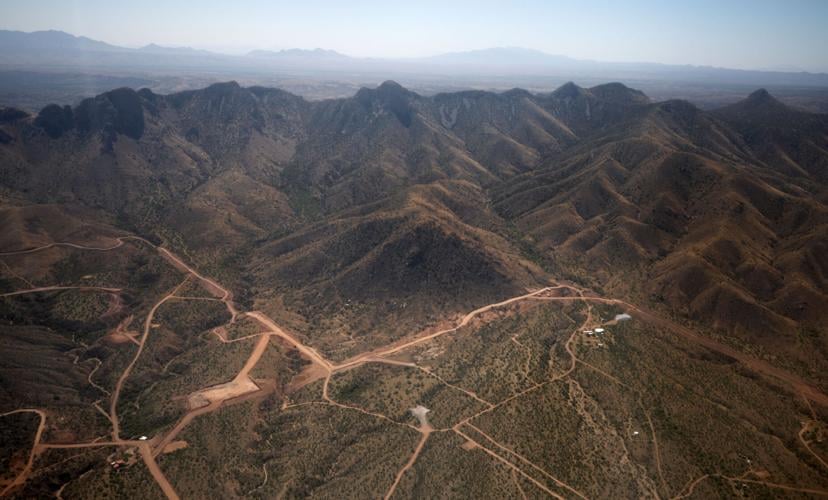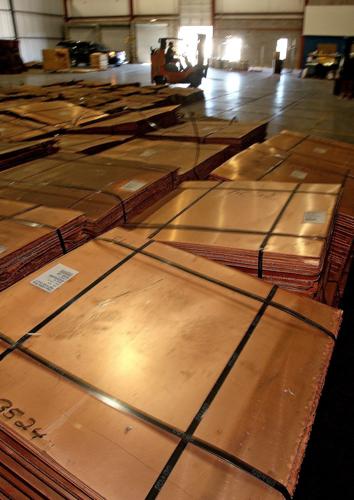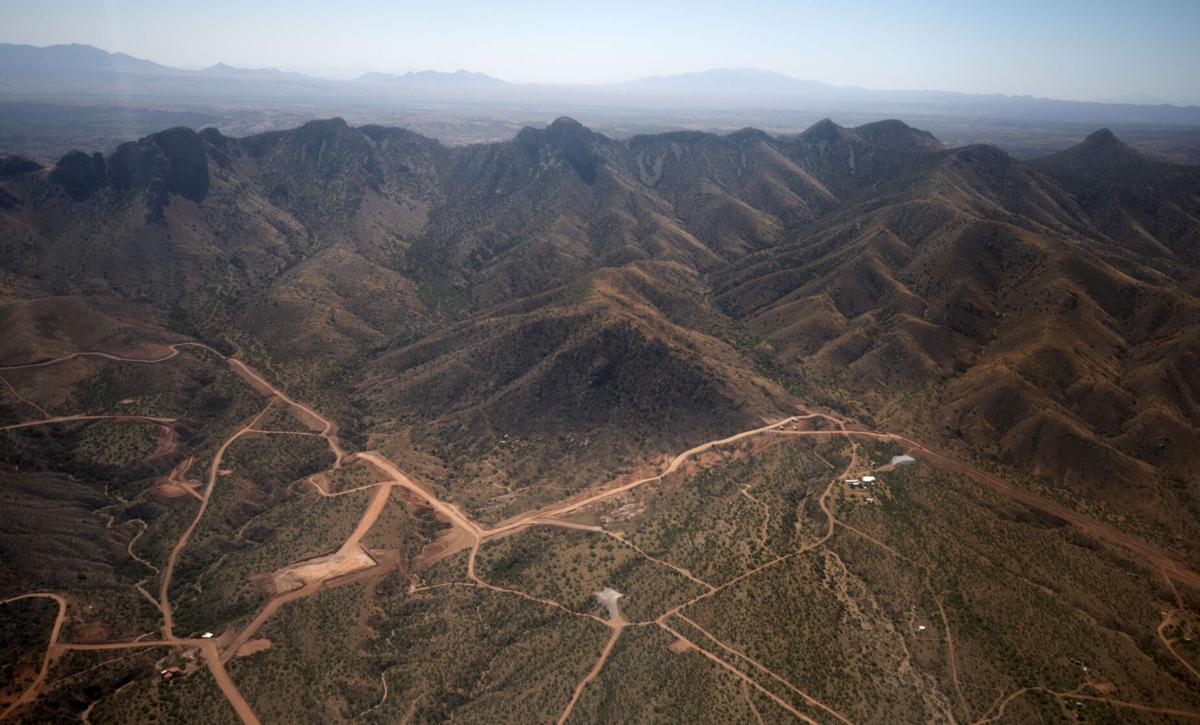Hudbay Minerals Inc. hopes federal tax credits will pay part of a $367 million tab for a new leaching plant it plans to build at its massive, proposed Copper World mining complex in the Santa Rita Mountains south of Tucson.
The company is seeking the tax credits, for an amount not yet publicly known, under a federal program created to strengthen the competitiveness of U.S. industry and bolster production of “green energy” projects that use minerals including copper.
Various experts say there’s a good chance Hudbay’s leaching plant will qualify for the tax credits, newly available to copper producers. In part, that’s because the facility would process and refine copper at the mine site, rather than the mine having to ship unrefined copper concentrate overseas, transportation that burns fossil fuel and releases greenhouse gas emissions.
Hudbay’s desire for the tax credits and their very availability underscores a deeper division among industry officials, outside experts and environmentalists over the need for new extractive mining projects to advance a “green energy” future.
The Biden administration, many industries outside of those producing fossil fuels, and environmentalists agree we need more renewable energy supplies such as solar panels and wind farms. But while the administration, industry and some independent experts say more mining is needed for green energy, many environmentalists continue to resist construction of more mines on environmentally sensitive lands.
Hudbay’s plant would make cathodes, thin sheets of pure copper, out of concentrate extracted from ore the company plans to mine from three open pits it would dig on the Santa Ritas’ west slope.
But a potential question mark for Hudbay is timing. It will have to show it’s using the tax credits in two to three years after they’re granted, various federal rules and regulations say.
The company’s timeline for getting the mine built and open is unknown. Hudbay also hasn’t committed to a specific timeline for getting the concentrate leaching facility online.
An academic expert in these matters, Ian Lange of the Colorado School of Mines, says that due to the realities of permitting issues for mines, he thinks the U.S. Department of Energy “will try to provide companies as much slack as they can within the law.”
However, Rob Peters, an opponent of Copper World who directs the group called Save the Scenic Santa Ritas, asks, “Why give tax incentives to a project where it’s not even clear when mining would take place?”
“Made in America” copper
Projects involving copper have been eligible to receive the tax credits since the end of July. That’s when the Department of Energy put copper on its list of critical materials needed to help with the transition to greener forms of energy.
The tax credits can cover up to 30% of the total cost of projects.
Since announcing the copper leaching facility a year ago, Hudbay has promoted it as a way to reduce its emissions of heat-trapping greenhouse gas emissions. By producing fully processed copper cathodes, ready for use, the Toronto-based company says it wouldn’t have to ship unrefined copper concentrates out of the country for smelting and other forms of processing; the U.S. lacks smelting capacity.
The project is designed to produce “Made in America” copper, the company told investors in a presentation last month.
Its 2022 preliminary economic analysis for Copper World proposed getting this facility online from the start of mining. But its recently released, preliminary feasibility study said it would save on initial capital expenses by waiting for year five to bring it online.
If it gets the federal tax credits, however, “we could be in a position” to bring the copper leaching plant online by the first year of copper production, Hudbay told the Arizona Daily Star on Wednesday.

Hudbay aims to produce copper cathodes, or stacks of copper plates, on site at its Copper World project in the Santa Rita Mountains. The cathodes shown here, in a 2016 file photo at the Port of Tucson, are from a different mining project.
Hudbay plans to build Copper World first on the west slope of the mountain range on several thousand acres of its land. That project would be an alternative to its now-shelved Rosemont Mine proposal on the Santa Ritas’ east slope, which was stopped by unfavorable federal court rulings in 2019 and 2022. The company has said that over time, it will return to the east slope to mine a fourth pit it plans.
It plans to operate the entire Copper World project over 44 years, with the first phase lasting 20 years, Hudbay told investors last month.
That’s far longer than the 19 years that Hudbay and its predecessor had planned for the earlier Rosemont Mine that would cover only the east slope area.
The company has pledged to create at last 400 high-paying jobs for the entire project, and said it will generate $420 million during the mine's first phase in state and local tax revenues.
But opponents, including a half-dozen environmental and conservation groups and three tribes, have said it will use far too much groundwater and cause major habitat destruction.
Capital costs
Hudbay says that under its current plan in which the concentrate leach facility goes online in year five of production, the project’s total capital cost would be $1.3 billion.
An earlier, preliminary economic analysis from 2022 pegged Copper World’s capital cost at $1.9 billion, and assumed the leaching facility would be 100% online in year one.
Hudbay said the concept now is a “simpler and more traditional process” that reduces the immediate capital cost and allows construction of the leach facility to be “self-funded” by revenues from the mine’s copper sales in years one to three of production.
The leaching technology’s design will give the company flexibility to build the facility when the economics would work best and increase its size at “any point in the future.”
The new pre-feasibility study shows Copper World is “economically robust” on a standalone basis, without the copper concentrate leach facility. Including the leach facility over time further enhances its economics, Hudbay said.
Critical material
Hudbay is seeking the tax credits under a program aimed at helping what the federal government calls Qualified Advanced Energy Projects. The credits will go to projects that DOE finds will expand clean energy manufacturing and recycling and critical materials refining, processing and recycling, or will reduce greenhouse gas emissions at industrial facilities.
These tax credits have been available to such projects, although not those involving copper, since the early years of the Obama administration.
The program was recently stoked with an infusion of $10 billion worth of additional credits, authorized in last year’s Inflation Reduction Act. These credit funds were put into the act as part of a much broader series of tax credits aimed at promoting various kinds of “green energy” projects. The first batch of tax credits to be awarded in this program will total $4 billion.
Hudbay told the Star it believes it qualifies for the credits because “producing copper cathode at Copper World provides a domestic supply of copper, a critical material for clean energy production.
“Additionally, on-site copper production reduces the operation’s total energy requirements and greenhouse gas emissions by eliminating the overseas shipping associated with a typical copper concentrate operation.”
Under federal law and rules, applicants must meet a number of qualifications to be considered for the credit -- qualifications laid out separately by the Internal Revenue Service and the DOE. DOE will recommend which entities should get a tax credit. IRS will make the decision.
DOE, for one, will base its recommendations in part on a project's commercial viability and the amount of greenhouse gas emission reductions it will generate. It will also evaluate whether a project strengthens U.S. supply chains and domestic manufacturing to prepare for an economy whose ,greenhouse gas emissions are, on balance, zero and on how effectively a project contributes to "workforce and community engagement."
IRS has said it intends to decide recipients of the first round of tax incentives by March 31, 2024.
Hudbay’s tax credit effort stands a good chance of succeeding, in part because of continued pressures from the federal government to produce more copper for use in “green energy” products such as solar panels and electric vehicles, said Lange, director of the mineral and energy economics program at the Colorado Mine School’s Payne Institute of Public Policy.
Every consulting firm and many academics who have been forecasting future copper and green energy needs have discussed “the large shortage of copper that is coming down the pipeline if we want to meet the goals the Biden administration has laid out” to replacing fossil fuels with renewable energy products such as solar power and electric vehicles, Lange said.
“DOE folk are well aware of these projections so I would imagine are happy to receive projects that focus on copper. The fact that the project is in Arizona, which often ranks as a top area to mine, has to reflect positively on the request,” Lange said.
Aaron Mintzes, an attorney for Earthworks, a national environmental group that often opposes regulations favoring the mining industry, said he agrees that the Copper World concentrate leach facility will be eligible for tax credits because of its critical material status with DOE -- if it's built soon enough.
His group had opposed the critical material designation for copper, unsuccessfully arguing that the risks to the short- and medium-term supplies of the material aren’t high enough to warrant designation. Mintzes is a senior policy counsel for the group.
The longest-running opposition group to Copper World, Save the Scenic Santa Ritas, said it hasn’t studied the highly technical details of IRS standards for the tax credit program well enough to be able to say if the company’s leaching facility would meet them.
But the group’s director Peters added, “The federal government should direct its tax incentives to projects that would produce critical minerals in short supply in the U.S., not to Canadian company Hudbay’s speculative, environmentally catastrophic project.” Peters said there are abundant existing supplies of copper that are 100% recyclable.
When the mining will start
Regarding the project’s schedule for starting mining, Hudbay has said it hopes to get its needed state permits governing air quality and aquifer protection in 2024. It plans to make a final decision on whether to start mining in 2025, after completing a final feasibility study, costing up to $90 million.
But Hudbay declined to respond to a question from the Star about when it hopes to get the mine started. When the Rosemont Mine was proceeding through its permitting during the 2010s, the project’s then-proponent, Vancouver, B.C.-based Augusta Resource Corp., repeatedly made projections for getting the mine operational that turned out to be far too optimistic.
Hudbay, however, has been much more cautious in projecting a timetable for opening the mine. And while Copper World needs only state permits to start operating on the west slope in its early years, which could save the company considerable time, even those permits will face opposition from environmentalists and tribes.
It has funding in place for the final feasibility study, and may also consider seeking a joint venture partner on the project before proceeding to invest in the project, the company said in its pre-feasibility study this year.
It may also sell to another company. In July, the Reuters news service quoted Hudbay CEO Peter Kukielski as saying the company will entertain acquisition offers provided the price is right.
Hudbay operates copper mines in Peru, Canada and the United States and is seen by analysts as a potential acquisition target of large miners as they rush to secure copper supply for the transition towards electrification, Reuters reported.
“We are a friendly company,” and the management and board are not against receiving an offer, said Kukielski, according to Reuters. He added that if the company receives a preemptive offer it will go to its board and shareholders. “But if they undervalue our company, they are wasting our time,” he said.
Save the Scenic Santa Ritas has seized upon the various uncertainties about Copper World’s timetable and now Hudbay’s future to oppose the use of federal tax credits for the leaching facility.
The Payne Institute’s Lange said, however, “This is a tough one to really have strong feelings on. Obviously it would be better if Hudbay was more open with their thinking on timing but I have a hard time faulting them for trying to hedge the dates a little, given the current realities.”
This flyover shows the Santa Rita Mountains’ west slope, where Hudbay Minerals has been grading and land-clearing since April 2022 for its planned Copper World Mining Project. Video courtesy of Center for Biological Diversity.




